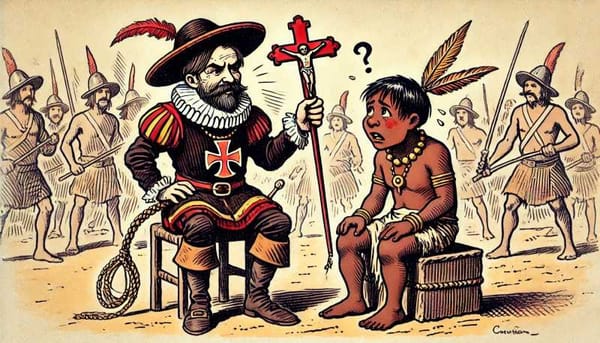Who really discovered America and what happened on October 12, 1492
Through the works of Miguel León-Portilla, Edmundo O'Gorman, and Federico Navarrete we can glimpse historiographic paradigms that differ from Eurocentrism, what happened on October 12, 1492: the discovery of America?

Through the works of Miguel León-Portilla, Edmundo O'Gorman, and Federico Navarrete we can glimpse historiographic paradigms that differ from Eurocentric, traditional, and conventionalist gazes of what happened on October 12, 1492: Discovery of America?
The development of navigation, the need to find another commercial route to India, and the interest in achieving territorial and religious expansion for commercial and economic purposes were some of the antecedents that led Spain to enter the ocean through unexplored routes with the promise of great profits.
This led the Genoese navigator Christopher Columbus to leave Europe in 1492 with three ships and a crew of about a hundred men in search of India. This voyage was made with the economic investment of Isabel de Castilla, some members of the nobility, merchants, and magnates.
Thus, on October 12, 1492, Christopher Columbus reached what we know today as America by meeting the Antilles and disembarking on the island of Guanahaní, which he baptized with the name of San Salvador (later arrived in the current territories of Santo Domingo and Cuba).
This episode of history is commonly known as the "discovery of America," and has been taught in Latin American schools for decades. Even towards the XX century, the date began to be institutionalized becoming an attempt of vindication that enaltecía the nationalist values and exposed a species of pride centered in the mestizaje, at the same time that supposed that the origin of the magnanimity and national civility was in the European or western root that gave place to that mestizaje.
The Day of Discovery and Race, the Day of Race and Hispanic, the Day of Race, and the Day of the National Holiday are some of the names with which this date began to be officially commemorated in Spain, Colombia, Costa Rica, Argentina, Mexico, and other Spanish-speaking countries.
However, the term "discovery of America" has been called into question by many researchers and historians who find in the name a serious problem, because it reduces, simplifies, or invisibilizes the complexity of social relations and power that arose with the coming of the Spanish conquerors while suppressing the validity and existence of history, a territory, and civilization before their arrival.
"The indigenous peoples of the continent who had remained unknown to the Europeans only enter the scene when it happens that they are 'discovered', 'conquered', 'Christianized' and 'colonized'", points out the recently deceased Miguel León-Portilla in his text Encuentro de dos Mundos, presented in 1992 at the International Conference: Rewriting History, which took place in Baja California.
In addition, he adds: "The ignorance and disdain of not a few Europeans regarding the cultural trajectories of the native peoples of the New World was later accompanied by their disinterest in the history of the colonies that were implanted there and the nations that later achieved independence.
In this text, Miguel León-Portilla points out some positions found in "universal history" and in the positions of some philosophers concerning the inhabitants of the "New World", in them are visions that qualify the indigenous people as "primitive", "almost animals" and "incapacitated". Faced with these arguments, León-Portilla warns of bias in the way in which knowledge is constructed about the American continent (excepting the United States) and about what has been called the "discovery of America".
In Visión de los vencidos (1959), Miguel León-Portilla includes an expression that offers a perspective that invites reflection on how this moment in history is narrated and explained. It is the term "encounter of two worlds".
Through it León-Portilla shows that following the arrival of the Spaniards in what we now call America, there was room for a process that resulted in "the fusion of peoples and cultures", as well as "exchanges of all kinds"; precisely, through the idea of the "encounter of two worlds," a position is adopted that takes into account all the participants in this process: both the indigenous settlers and the Africans brought to these lands and the Spanish conquerors.
León-Portilla also points out that another meaning is found in this expression since "encuentro" also alludes to or is related to "contra" and has as its meaning "choque", "enfrentamiento" and "lucha", which refers to the invasion, subjugation, exploitation, and murder of indigenous people, as well as the resistance of these settlers.
The Tlamatini was not the only historian to highlight the one-sided perspective of the idea of the "discovery of America".
Shortly before the author of Visión de los vencidos spoke of a "meeting of two worlds," Edmundo O'Gorman analyzed the question of discovery under an unconventional gaze (perhaps the opposite of that of León-Portilla) and which, in the historian's own words, "sowed chaos" in the Mexican academy, as he questioned the traditional historical interpretations of Columbus' arrival in America.
For O'Gorman, America simply could not have been discovered, because America did not exist. This postulate is found in the book The Invention of America (1958); in this text, O'Gorman argues that America was not discovered, but was invented, so for the historian it is necessary to reconstruct history, not of the discovery of America, but of the idea that America was discovered.
"The fundamental problem of American history lies in satisfactorily explaining the appearance of America in the heart of Western Culture, because that question involves, no more and no less, how the being of America is conceived and the meaning to be given to its history. Now, we all know that the traditional answer is to affirm that America became apparent as a result of its discovery, an idea that has been accepted as something of its own and constitutes, today, one of the dogmas of universal historiography," O'Gorman points out in his book.
He also adds: "When we are assured that Columbus discovered America, it is not a fact, but merely an interpretation of a fact. But if this is so, it will be necessary to admit that nothing, except laziness or routine, prevents the validity of that particular way of understanding what Columbus did on that memorable date from being called into question, since, in short, it is but one possible way, among others, of understanding it.
O'Gorman assures that with this new perspective America can be understood not as an entity that postulates itself a posteriori and unalterable, but as the result of a historical process that implied the "seizure of those lands by Europe, to carry out its culture in those lands". And under this new light, the events following the "invention of America" (conquest, colonization, and independence) can be analyzed differently and acquire a new meaning.
Finally, more recently, the historian Federico Navarrete has offered various elements to understand under another lens what is unquestionably called "discovery of America".
In 2016, the author of La Conquista de México (2008) and México Racista (2017) presented an article entitled Las historias de América y las historias del mundo: una propuesta de cosmohistoria, in which Navarrete points out that the arrival of America and its inhabitants to universal history (the history of Europe) was made with the traditional image of Christopher Columbus' disembarkation in what we now know as The Bahamas.
According to the author, that moment, narrated by Columbus himself, gave the key elements that gave shape to the vision of the Europeans about this "new continent" and that gave way to the establishment of relations of colonial domination. It is through the idea of discovery that domination is imposed, because for Navarrete the idea of discovery entails the subordination of America to Europe, and turns the former into an extension of the latter.
"The ease with which the 'discoverer' began to dispose of the territory and the lives of the Americans is inseparable from the very idea of discovery. For the Europeans the lands they found (...) and also their inhabitants, were unknown and that meant that they were available to do their will with them", points out Navarrete.
In addition, he comments: "The idea that Europeans 'discovered' America implies privileging the gaze of newcomers over the point of view of the people who already inhabited the continent. It also involves privileging Western knowledge, geography, and history over Native Americans' knowledge and conceptions of space, time, and their lands. From this perspective, a territory is only 'discovered' when it is incorporated into European maps when it receives a European name when it forms part of the European knowledge of the world.
Through the works and contributions of Miguel León-Portilla, Edmundo O'Gorman, and Federico Navarrete we can glimpse historiographic paradigms that differ from the Eurocentric, traditional, and conventionalist gazes in which history is told unilaterally, that is, utilizing a single and absolute voice. In this way, history is less rigid and more subject to reinterpretations and analyses that envision new ways of understanding our future.
Source: Secretariat of Culture




